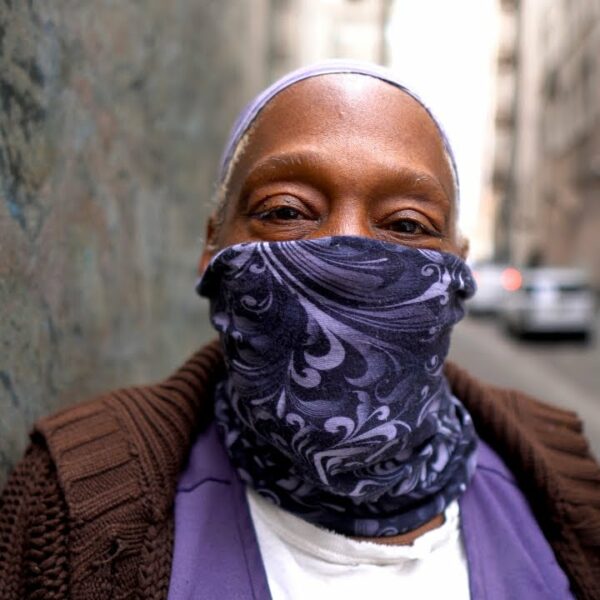Hennepin County’s Danielle Werder Says Yes
“We try to support people through housing-focused case management. We believe this is the secret sauce. We have all these places for people to go, but we need people to help them get there.”
Danielle Werder shares her advice for reducing chronic homelessness
Chronic homelessness is one of the most challenging types of homelessness to solve. Chronically, homeless people often carry the most trauma, need the most help, and find themselves in circumstances where exiting homelessness seems downright impossible.
In this article, we interview area manager of the Hennepin County Office to End Homelessness, Danielle Werder, whose efforts have helped reduce chronic homelessness in Minneapolis by 80%.
To put some perspective on the issue, the region’s number of chronically homeless people declined from 1,490 people in 2017 to just 342 people last year. Here’s a look at some of the strategies she and her colleagues used to achieve something rather close to “functional zero.”
What does it mean to achieve a functional zero for chronic homelessness instead of a functional zero for all homelessness?
Danielle Werder: “So, for chronic homelessness, the calculation HUD suggests is that less than 1% of your community fits that definition. For us, that’d be three people experiencing chronic homelessness. But what that really means is that, once we achieve functional zero, if somebody kind of flows into chronicity, which is what we talk about, if someone has been homeless for a year or close to it, say 11 months, then we would be able to immediately identify that person and their homelessness.”
“Not having more people experiencing chronic homelessness once we achieve that functional zero is really about inflow and outflow. On any given day, we can have new people who are meeting this definition and people exiting our homeless response system into housing. So, it’s not a static number. To achieve this goal, it’s not just about housing people experiencing chronic homelessness. It’s about preventing people from ever becoming chronically homeless.”
Data suggests that in corroboration with Community Solutions, Hennepin County has already drastically reduced chronic homelessness by nearly 80%. How did you arrive at this number, and what were some of the key strategies that helped achieve such a milestone?
Danielle Werder: “We’ve been tracking our data since June 2017. The reason we started tracking our data is because we made a commitment. We aimed to end chronic homelessness in Hennepin County, which meant undertaking some really thoughtful work and intervention on all sides of things, both within our infrastructure, our policies, how we organize our data, how we use that data, how we prioritize people for homeless dedicated units, and how we work with the community to join with us on this goal.”
“It hasn’t just been one thing. We use a community solution and Built for Zero’s best practices around trying different tests. We’re always testing assumptions and measuring that data and those outcomes. And when things are working, we double down. And when things are not working, we try something else. We know who is in our system, what they need, where they are, who’s working with them, and how we can help by using that information to intervene and move them into housing quickly.”
What percentage of chronically homeless people in Hennepin County are veterans?
Danielle Werder: “I’m very excited to answer this question. So, for Hennepin County, we focus on people who are literally homeless. This means people either in a shelter or staying in a place not meant for human habitation. When we focus on that population, because there are way too many people in that huge crisis of experiencing literal homelessness, we find that is the majority of the veterans we have. We’re avidly working towards ending veteran homelessness, and we’re doing a very good job.”
“What we looked at in our most recent meeting was that there were six veterans who were also chronically homeless. And that’s down from over a hundred a couple of years ago. So, it’s been some really successful work. And the great thing is – part of what Community Solutions and Built For Zero are doing – is infusing resources into our community to intervene in this specific population. The good thing with veterans is that there are resources online through federal veteran’s agencies that have helped us to reduce those numbers.”
“So, when we’re combining efforts and saying, all right, we want to end all chronic veteran homelessness, we have even more resources to deploy and try to get us over that position.”
How does the program work?
Danielle Werder: “It’s not a program. It’s a system. We really tried to work with people to create a system that can best serve people wherever they are on their journey. When I say literal homelessness, I’m talking about the thousand people in emergency shelters and those sleeping outside.”
“We know people move back and forth between shelter and unsheltered settings. In the end, it’s really about creating a system that can meet people wherever they’re at and intervene and not let being outside or being within certain shelter walls be a barrier to access housing.
“The way we hope our system works, and I will be the first to admit, it’s not perfect, but the system we’re building is serving people better than ever. We were recently able to implement a diversion program called Hennepin Shelter Hotline. And what diversion does is prevent homelessness, which is why we put it at the very, very top of our system.”
“That’s going to be people’s first call, and if anybody has any alternative to shelter – if they can stay with that roommate, but they just need them to pay them $15 a night, and then they can move into their apartment in a month – we can help facilitate that rather than having them enter a shelter and experience everything related to that.”
“It’s really about posing creative conversations to find alternatives and connect people to housing. So that’s our first layer – diversion. If somebody has nowhere else safe to go, the Hennepin Shelter hotline transfers them to the adult Shelter Connect or the family shelter team.”
Where do they go from there?
Danielle Werder: “We understand that shelter is not housing. It is sometimes a stop on the journey toward housing. We’ll get people into the best place possible. Sometimes, we have incapacity issues, but we have a shelter system that turns over several times a day to accommodate people throughout the day.”
“If people are experiencing unsheltered homelessness, we know there are many valid reasons why somebody would opt out of shelter. Examples include former trauma, needing to be with a family member who’s not eligible for shelter, having a plan, having a partner, and having addiction issues.”
“So many reasons. Right?”
“So, we’ve created a team called Streets to Housing and partnered with other outreach teams. The goal is to engage people in housing-focused conversations, get them benefits, get them basic needs, and, most importantly, get them into housing. Throughout these interventions, if somebody is eligible for our coordinated entry system, which is really just our access point to our homeless dedicated units, then we’re able to do that assessment.”
“We prioritize housing because demand always exceeds supply. We do need to prioritize individuals. We have worked with people with lived experience to prioritize medically vulnerable people and people experiencing chronic homelessness. That’s how we work thoughtfully to utilize our very precious housing resources to really meet the needs of people out there.”
Can you give examples of how you prioritize and meet individual needs?
Danielle Werder: “If somebody doesn’t need supportive services, we don’t want to put them in a supportive service setting. Understanding people’s wants, housing preferences, and housing barriers is key. Lastly, we support people through housing-focused case management. We believe this is the secret sauce.”
“We have all these places for people to go, but we need people to help them get there. Therefore, we assign people on a one-to-one basis.
These case managers are just joining them on their housing journey, breaking down barriers, paying off unlawful detainers, expunging warrants, finding units, taking people on tours, helping fill out applications, appealing denials, etc. People get denied just because it’s a complicated system.”
“How do you get your Social Security card? How do you get your ID? The system asks people to do all that, keep track of appointments, and call their landlords back. It’s too much when they’re experiencing a deep crisis of homelessness, and perhaps they also have a disability. On top of that, they’ve been homeless for a year and lost faith in our system.”
“Having these housing-focused case managers join them is very impactful. I’m thrilled to say that our homeless housing team, which isn’t even all of our case managers, it’s just one internal team, has housed over 600 people in under two years with a 95% retention rate.”
Are all of Community Solutions’ approaches to homelessness non-punitive, meaning they do not enlist the aid of law enforcement?
Danielle Werder: “Oh, yes. I mean, and that’s us too. We do services. That’s what we do. We’re person-centered. We’re trauma-informed. We engage with people. We join them on their journey, wherever they’re at.”
“For example, if somebody had said yes at one point to housing case management, and we show up in the shelter, and we’re saying, Hey, we’re your case manager, and they’re just having a day, and they’re like, ‘No, nope. Go away. I don’t wanna talk to you.’ We’ll show up the next day because we don’t take it personally. We just want to help.”
“People can take their time because everything is voluntary and really based on that person-centered, trauma-informed care. And I believe Community Solutions and Built for Zero approach the work in the same or a similar way.”
How do you involve people with lived experience in homelessness in policy-making and other decisions?
Danielle Werder: “Our entire system is better and stronger because we draw from people with lived experience of homelessness. We work with a couple of different groups. We always engage people on the street and in the shelter systems. But there’s a group called Street Points of the Change, which is a lived experience advisory group here in Hennepin County. They’re active, they’re amazing. Our office is there several times a month.”
“They become the policy. For example, we ask them about community cars, and we ask them about changing how we do shelter reservations. Their opinions and viewpoints are going to directly become policy. We also involve people with lived experience in all of our hiring. We have an internal group called the Lived Experience Advisory Group.”
“They’re also amazing. We don’t hire anybody without also having somebody with lived experience. At least one, usually two or three people, fits this description on our panel. The feedback they’re giving is so vital and so impactful. The other thing that we always do is in any request or proposal, any funding decision, we include multiple people with lived experience.”
“The last group we work with is called the Youth Action Board. The voice of young people is really important to incorporate as well. We have transformed our work to partner with people with lived experience. We don’t make any policy decisions, or we’re not planning a community meeting without PEH as part of our planning committee and our actual presentation to the community. I’m really excited about where we’re going with that. And it’s becoming just a daily part of my work.”
What are some of the gaps that people experiencing homelessness identified that other professionals might not have revealed?
Danielle Werder: “When we hear about a call, wait time hearing about it is different than physically standing with somebody hearing that music and knowing they don’t have a place to stay. It’s understanding how the system impacts their day-to-day lives and experiences and then trying to improve it. In that example, we’re doing everything we can to increase staffing and budgets so that we can have no wait times. Nobody should have to wait on the phone when they’re already waiting to be housed.”
“That’s just one example. There are lots of little things, like we were missing certain hours of coverage in the day. So PEH pointed out that there was no drop-in center open for about two hours. To us, it’s like, okay, maybe it’s two hours, but to them, it’s like, where do I go? So we needed to correct that immediately.”
“It’s from our privileged space as service providers and local government that we miss what it’s actually like to move through the system. And even the best intentions can still resolve something that’s not working well for somebody. For this reason, we are always open to that feedback.”
Talk to Your Lawmakers About Implementing Some of These Tried-and-True Tactics
Using sophisticated data, lived experience committees, and a system based on trauma-informed care, Hennepin County is on track to reduce chronic homelessness to functional zero by the end of 2024. Talk to your lawmakers about taking some of these successful strategies to the next level by implementing them nationwide.













